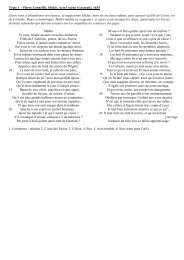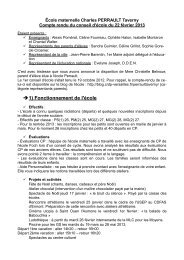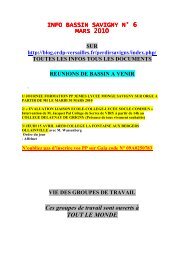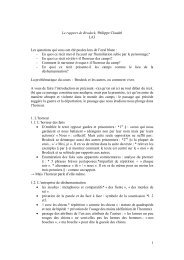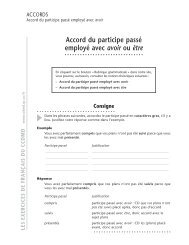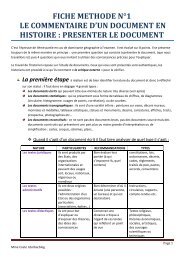diaporama des nombres heureux
diaporama des nombres heureux
diaporama des nombres heureux
You also want an ePaper? Increase the reach of your titles
YUMPU automatically turns print PDFs into web optimized ePapers that Google loves.
Heureux ou Mal<strong>heureux</strong> ?<br />
I. Définition du problème<br />
II. Les <strong>nombres</strong> <strong>heureux</strong><br />
III. Les <strong>nombres</strong> mal<strong>heureux</strong><br />
IV. Elargissement<br />
V. Conclusion
I. Définition du problème<br />
a + b = n<br />
a x b = n x k<br />
Avec a et b entiers positifs et différents<br />
de 0
Exemples de <strong>nombres</strong> <strong>heureux</strong><br />
On choisit le nombre 9.<br />
3 + 6 = 9<br />
3 x 6 = 18<br />
18 est divisible par 9, nombre de départ.<br />
Donc 9 est <strong>heureux</strong>.<br />
De même, 12 est <strong>heureux</strong> :<br />
6 + 6 = 12<br />
6 x 6 = 36<br />
36 est divisible par 12.
Exemples de <strong>nombres</strong> mal<strong>heureux</strong><br />
1 + 2 = 3<br />
1 x 2 = 2<br />
On choisit le nombre 3.<br />
2 n'est pas divisible par 3,<br />
3 est mal<strong>heureux</strong>.<br />
De même, 5 est mal<strong>heureux</strong> :<br />
Deux possibilités :<br />
1 + 4 = 5<br />
2 + 3 = 5<br />
1 x 4 = 4<br />
2 x 3 = 6<br />
Ni 4 ni 6 ne sont divisibles par 5, donc 5 est<br />
mal<strong>heureux</strong>.
II. Les Nombres Heureux<br />
A) Le carré d'un nombre entier<br />
Exemple :<br />
9 = 3²<br />
3² = 3 + (3² – 3)<br />
n a b = n-a<br />
a x b = 3 x (3² – 3)<br />
= 3² x (3 – 1)<br />
n<br />
k
Démonstration :<br />
n = d²<br />
d² = d + (d² – d)<br />
n a b = n-a<br />
a x b = n x k<br />
a x b = d x (d² – d)<br />
= d² x d – d²<br />
= d² x ( d – 1)<br />
n<br />
k
B) Multiples du carré d'un entier<br />
Exemple :<br />
12 = 3 x 2²<br />
3 x 2² = 3 x [ 2 + (2² – 2) ]<br />
= 3 x 2 + 3 x (2² – 2)<br />
a<br />
b<br />
a x b = 12 x k<br />
a x b = 3 x 2 x [ 3 x (2² – 2) ]<br />
= 3 x 2² ( 3 x 2 – 3)<br />
n<br />
k
Démonstration :<br />
n = q x d²<br />
q x d² = q x [ d + (d² – d) ]<br />
= q x d + q x (d² – d)<br />
a<br />
b<br />
a x b = n x k<br />
a x b = q x d x [ q x (d² – d) ]<br />
= q x d² ( q x d – q )<br />
n<br />
k
II. Les <strong>nombres</strong> mal<strong>heureux</strong><br />
Décomposition en facteurs premiers<br />
Tout nombre peut s'écrire sous la forme de<br />
produits de facteurs premiers.<br />
N = f 1 a1 x f 2 a2 x f 3 a3 x … x f n<br />
n<br />
Exemple : 200 = 2 x 2 x 2 x 5 x 5<br />
= 2 3 x 5 2
A. Nombre premier<br />
13 = n<br />
a + b = 13<br />
=> a
Démonstration<br />
p = n<br />
a + b = p<br />
=> a
B. Multiples de <strong>nombres</strong> premiers<br />
différents<br />
3 x 5 = p 1<br />
x p 2<br />
= n<br />
a x b = n x k<br />
a x b = 3 x 5 x k<br />
3 divise a ou 3 divise b<br />
a + b = p 1<br />
x p 2<br />
3 divise 3 x 5 , 3 divise a<br />
Donc 3 divise b !<br />
Où est 5 ?
Démonstration<br />
p 1<br />
x p 2<br />
= n<br />
a x b = n x k<br />
a x b = p 1<br />
x p 2<br />
x k<br />
p 1<br />
divise a ou p 1<br />
divise b<br />
a + b = p 1<br />
x p 2<br />
p 1<br />
divise a<br />
Donc p 1<br />
divise b !<br />
Où est p 2<br />
?
V. Élargissement
VI. Conclusion<br />
Tous les <strong>nombres</strong> carrés ou multiples<br />
de carrés sont <strong>heureux</strong> !<br />
Tous les <strong>nombres</strong> premiers ou produits<br />
de <strong>nombres</strong> premiers différents sont<br />
mal<strong>heureux</strong>...




